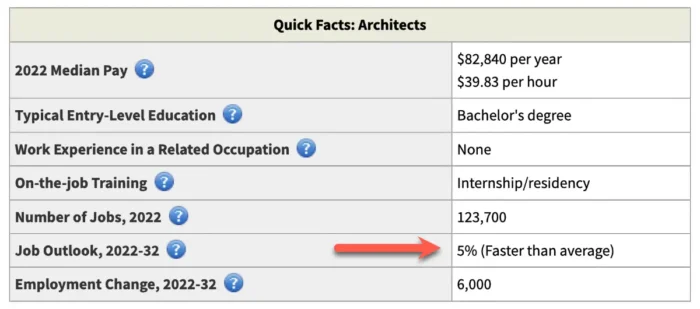Going into a career in architecture is a decision often fueled by passion, creativity, and a desire to impact communities through design and innovation. While it’s a profession steeped in history and tradition, modern architecture constantly evolves, with architects at the forefront of exploring new materials, technologies, and design strategies.
This guide serves as a stepping stone for those considering a career in this dynamic field, providing a comprehensive overview of what you can expect, the skills you need, and the opportunities that lie ahead.
Education and Training
To become an architect, you must obtain a professional degree in architecture. This typically takes five years for a bachelor’s degree or two to three years for a master’s degree. Coursework will cover topics such as architectural history, building design, and computer-aided design and drafting (CADD).
After completing your degree, you must complete a paid internship, usually for three years. This practical experience is an essential part of your training. During this period, you’ll work under the supervision of experienced architects, who will provide guidance and feedback.
Finally, all states require architects to become licensed before practicing independently. The licensing process involves passing the Architect Registration Examination (ARE), a challenging, multi-part exam administered by the National Council of Architectural Registration Boards (NCARB). In addition, ArchAdemia provides courses for careers in architecture if you need extra preparation for the ARE.
It’s important to note that licensing requirements may vary by state, so be sure to research the specific requirements of your desired location.
Necessary Skills and Abilities
Architects require a unique blend of skills and abilities. Strong graphic and design skills are crucial, as architects need to be able to convert conceptual ideas into plans and visualizations. Familiarity with CADD software is also essential, as most architectural design work is now done digitally.
Critical thinking and problem-solving skills are also important. Architects need to be able to identify and resolve issues that may arise during the design and construction process, such as ensuring that a design meets safety regulations or fits within budget constraints.
Lastly, architects need to have strong communication and negotiation skills. They must be able to effectively communicate their ideas to clients and other stakeholders, as well as negotiate contracts, and manage relationships with contractors and other professionals involved in a project.
The Role of Technology in Modern Architecture
Technology is increasingly shaping the field of architecture. Innovative tools and technologies, such as building information modeling (BIM) and virtual reality (VR), can transform how architects design and visualize their projects.
BIM allows architects to create detailed 3D models of a building, enabling them to better visualize and plan the construction process. This can lead to more efficient and accurate designs and improved collaboration among the different parties involved in a project.
Meanwhile, VR technology is being used to create immersive design experiences. This allows clients to virtually walk through and experience a proposed design from different perspectives, providing valuable feedback that can shape the final design.
Job Outlook and Career Advancement
The job outlook for architects is positive, with the Bureau of Labor Statistics predicting a 5% growth in employment for architects from 2022 to 2032. This growth is driven by the need for environmentally friendly and sustainable designs and an increasing demand for architects in the construction of healthcare facilities and schools.

In terms of career advancement, many architects choose to specialize in a particular type of architecture, such as residential, commercial, or environmental design. Others may decide to take on management roles, overseeing the work of other architects and working closely with clients and contractors.
Additionally, some architects may choose to start their own firms. This path allows for greater creative control and potentially higher income but also increases risk and responsibility.
The Impact of Architecture on Society
Architecture plays a crucial role in shaping society and the environment. It influences how we live, work, and interact with each other. From the design of homes and schools to public spaces and landmarks, architecture can inspire, uplift, and transform communities.
At the same time, architecture also significantly impacts the environment. Architects are increasingly being challenged to create designs that are not only aesthetically pleasing but also sustainable and environmentally friendly. This includes considering aspects such as energy efficiency, waste reduction, and the use of sustainable materials.
Challenges and Rewards of a Career in Architecture
A career in architecture can be both challenging and rewarding. Architects often face long hours, tight deadlines, and the pressure to meet client expectations. The design and construction process can also be complex, requiring architects to coordinate with various professionals and navigate various regulations and constraints.
However, the rewards can be substantial. Architects have the unique opportunity to shape the physical world around us, creating functional and beautiful spaces. Seeing a project come to fruition, from initial concept to completed construction, can be immensely satisfying.
Conclusion
In conclusion, a career in architecture requires a combination of education, skills, and passion. It’s a field that offers endless possibilities for creativity and impact, with technology constantly pushing the boundaries of what is possible. You can embark on a fulfilling career in this ever-evolving profession by acquiring the necessary training and skills, staying updated on industry developments, and being open to new challenges and opportunities.





